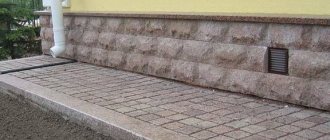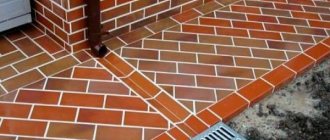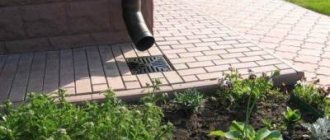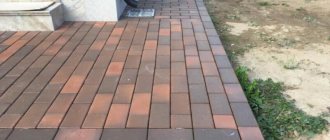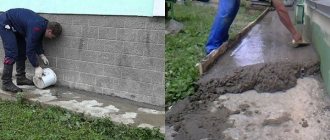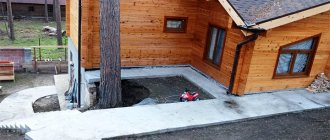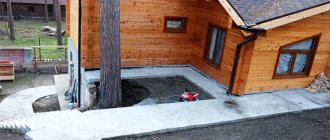Do-it-yourself drainage of the area around the house
If the site is located in a lowland or groundwater flows close to its surface, it is necessary to drain the area. It is optimal when the groundwater level is at a depth of more than 2.5 m from the surface.
If the distance is less than 1.5 m, then the bearing capacity of the soil decreases - it becomes waterlogged and saturated with water. This affects the settlement of the foundation and makes the construction of a basement or ground floor problematic.
To drain the area around the perimeter of the planned house, or better yet along the edges of the entire yard, they dig channels with a slight slope and organize drainage. The optimal width of such channels is 50-70 cm.
The depth is calculated in each case individually, since it depends on how much the groundwater level needs to be lowered. Drainage is laid as follows.
At a distance of 2-3 m from the house, dig a ditch with a depth equal to the base of the foundation. A 15-20 cm layer of clay is placed on its bottom, giving it the shape of a tray. Medium-sized stones are carefully laid on top, forming sides. Large stones are placed on top, forming a vault. Gravel or crushed stone 25-30 cm high is placed on it. Everything is covered with soil removed during excavation. Water will seep through the soil into the tray and flow in the desired direction.
How to drain melt and storm water from the foundation
To protect the foundation of the house from rain and melt water, you can use a blind area. Water can be drained by installing surface drainage trays along the blind area. It is worth remembering that in the spring the trays will become clogged very quickly, because melt water will run freely across the frozen ground without being absorbed into it.
Foundation blind area
In addition, at night the temperature will drop, the water will freeze, its drainage will be impossible, and the trays will become useless. It is more advisable to use a device made from trays in the summer: storm water will freely flow from the lawns directly into the drainage device. In addition, you can drain water with your own hands almost free of charge and more efficiently. This method is called watershed creation and landscape modeling.
To create a watershed, all you need is a shovel, a rake and a wheelbarrow to transport the earth. First of all, the parameters of the watershed are calculated: shape, length and width. A direct watershed line is drawn in large areas: near a private house, cottage, parking lot.
Small objects are limited by an arc-shaped watershed, at a distance of about four meters from the beginning of the foundation. In this case, drainage is carried out into a ditch or a special drainage well.
After marking the watersheds, you can begin to create them.
Drainage system
The purpose of a roof drainage system is to collect rain and melt water from the roof of a building and redirect it to drainage points. If there are no gutters or they are not constructed correctly, then the water flowing from the roof moistens the walls (this is especially dangerous for wooden buildings and unfinished exteriors of sand-lime brick houses), destroys the blind area and undermines the foundation.
If the roof has a large area and the flow of water from it is strong enough, it breaks up the garden paths, and the building ends up splashed with soaked mud for almost half a meter
The main rule when installing gutters is to divert water as far as possible from the foundation of the house. After all, if you install water collectors immediately under the drainpipes, the moisture will go into the ground under the foundation, and only the walls and garden paths will be protected! In addition, the soil adjacent to the foundation is usually looser than usual, so water quickly absorbs into it and seeps to the concrete base. In winter, it freezes, expands and begins to “tear” concrete structures.
To prevent this from happening, a blind area up to one meter wide is made around the perimeter of the house and drainage trays or point storm inlets are installed, which direct water flows into storm drains, drainage wells, etc. depending on the general drainage system on the site.
Drainage of water from the roof: features
Water drainage from the roof must be mandatory. For example, in winter a huge amount of snow falls on the roof, which accumulates on it and can simply break it. There is also another significant danger: during daytime snow melting, icicles may form in the evening. They, in turn, can fall on someone’s head. If you drain thawed snow and rainwater from your home, you can forget about the formation of icicles and the danger of them falling on someone’s head forever.
How to make a drainage system yourself, that is the question. You can immediately answer that this is not a complicated process; you can handle it yourself. To do this, you need to buy gutters and drainpipes at a construction hypermarket or market that will drain water from the roof. Gutters for draining water from the roof are the least expensive and simplest option. It is also the most popular. Installing gutters to drain water from your home is quite simple and can be done with your own hands.
There are three types of gutters:
- semicircular,
- rectangular or square
- trapezoidal.
How to decide which one is best for your building? You can only rely on your taste, and you should also take into account the design of the building. In terms of functionality, these gutters are practically no different; we can say that they are the same in their properties and characteristics. Therefore, the choice falls entirely on your shoulders.
You can only help with the choice of color: you should not buy light-colored gutters, since in winter the snow on them will melt more slowly than if they were darker. This happens because dark colors attract more solar energy. Light colors, on the contrary, reflect the energy of the sun, so the snow on them will melt more slowly. Also, many experts recommend installing storm gutters that are larger in size and therefore can withstand the loads during heavy rainfall.
There is nothing complicated in installing gutters, you just need to follow the instructions from the attached instructions.
The system for draining rain and melt water using gutters is as follows:
Water flows from the roof into an attached gutter; it travels along the gutter to a downspout, through which it flows down to the ground. But the problem remains unresolved; water continues to flow directly under the foundation of the house. To bring the water drainage system from the house to perfection, it is necessary to make an additional drainage system.
Reliable ways to drain water from the foundation of a house
Korovin Sergey Dmitrievich
Master of Architecture, graduated from Samara State University of Architecture and Civil Engineering. 11 years of experience in design and construction.
The foundation is the basis, the support of the building; the life of the house depends on its quality, strength and integrity. The integrity of the foundation is compromised, first of all, under the influence of water that comes into contact with it during rains, runoff of melted snow, rising groundwater levels (or constant presence of groundwater at a high level), etc. As a result, the foundation walls become wet, damp, and overgrown with mold. , and moisture gradually collects around and approaches the upper floors.
All of the above problems demonstrate the importance of timely drainage from the foundation of a building. Moreover, foundation drainage must be carried out during the process of creating a residential structure in order to carefully consider the design of the drainage system, calculate the angle of inclination, select suitable materials for drainage and calculate the depth at which structural elements should be located
Horizontal drainage system
Creating a drainage system requires certain financial investments and time, but is highly effective in combating groundwater. This is a complex engineering task in which it is necessary to take into account the characteristics of the site, the angle of inclination and the expected load.
Horizontal type of drainage
The choice of material from which the system will be made depends on the last factor. This can be plastic (at a low degree of load) and ultra-reliable concrete. It is also recommended to use cast iron gratings, which can reliably protect the drainage structure from deformation.
Protection of the foundation from melt and storm water
Protection against melt water
Seasonal formation of surface water is also a big problem. It can be solved with the help of comprehensive protection, which includes a drainage system, blind area and drainage system.
Drainage system
The design is designed to collect rain or melt water from the roof of a house. Water flows through special gutters into funnels and is carried away from the foundation of the building through pipes.
Ring drainage helps drain stormwater away from the foundation. It works like this:
Pipes are laid in an open trench that lead to a general sewer system. The pipes are laid on a compacted bed of sand and crushed stone.
It is very important that the diameter of the drainage and downspout pipes be the same. Wells are installed that receive water from drains. All water is collected in a common well, from which it is removed by pumping, direct drainage into an open reservoir, or absorbed into the soil through a drainage field.
Blind area
Water that accumulates on the surface is drained from the foundation using a blind area. Its arrangement looks like this:
- Marking in progress.
- A layer of soil is removed to a depth of 25 cm.
- The formwork is being installed.
- The soil is covered with a layer of clay and thoroughly compacted.
- This is followed by a 10 cm layer of sand, which is also compacted well.
- Fine gravel is poured on top of the sand in a layer of 5 cm.
- At the junction of the blind area with the wall of the house, an expansion joint of 2 cm must be formed.
- The blind area is filled with concrete.
Drainage
Water is removed from the drainage system and blind area through surface drainage. Its arrangement is carried out according to the following scheme:
- On the outside of the blind area, they dig a shallow ditch with a slight slope.
- The bottom of the trench is covered with sand and gravel, creating a sand and gravel cushion.
- Next, special trays are laid and covered with gratings.
When a drainage system is needed:
- site location. The lower it is, the more pressing the drainage problem;
- soil quality - on clay and loamy soils, the water level decreases slowly;
- precipitation levels in your area;
- groundwater level;
- deepening of other buildings on the site. If a nearby building has a deeply buried foundation, the water will have nowhere to go and will accumulate on the surface, increasing the risk of flooding;
- the presence of waterproof coatings - concrete paths, asphalt yard - these are places inaccessible to water penetration.
Installing drainage around the house with your own hands will eliminate the problems caused by the factors listed above.
Protection of the foundation from groundwater
Groundwater has a constant impact on the foundation, so it is important to create reliable protection for the foundation from this negative factor.
Very often, for greater efficiency, complex protection is used: trench drainage and foundation waterproofing. The drainage system is designed to drain water from the foundation, and waterproofing provides protection against moisture penetration into concrete structures.
Trench drainage
The drainage system can be open or closed.
Open drainage consists of ditches 50 cm wide and up to 1 m deep. The walls of the ditch are made with a slope of 30 degrees to ensure maximum accumulation of water. The length of the ditch must also have a slope for arbitrary water flow.
You can make closed trench drainage with your own hands according to the following scheme:
- A trench about 30 cm wide is dug along the perimeter of the base of the house; the depth should be slightly below the base of the foundation.
- Sand is poured onto the bottom in a layer of up to 10 cm, providing a slope.
- The sand is covered with geological textiles, fixed to the walls of the trench.
- Gravel is poured on top in a layer of 10 cm.
- Next, drainage pipes are laid. Many holes are drilled in them, thanks to which water will seep into the pipe and be directed to specially prepared places. The pipes must have a slope of 1 cm per linear meter.
- The pipes are covered with gravel, the layer of which above the pipe can reach 10 cm.
- The gravel is covered with geotextiles, the ends of which are sewn together.
- The end of the drainage pipe should be taken away from the base of the house at a distance of at least 5 m.
- The drainage system ends with a water intake, which can be an artificial or natural reservoir.
Foundation waterproofing
Waterproofing work protects the foundation of the house not only from groundwater, but also from soil moisture. Waterproofing can be horizontal and vertical. In the first case, the upper part of the base receives protection at the points of contact with the walls. In the second - the side surfaces of the foundation.
https://youtube.com/watch?v=a-26-EskN90
For vertical waterproofing, you can use several options:
- Protect the foundation with a layer of cement-sand mortar.
- Create insulation using bitumen mastic.
- Lay several layers of roofing felt or roofing felt.
Types of drainage
There are 2 types of drainage systems installed around the house, which are also divided into subtypes. They differ in purpose and immersion depth.
Surface
Surface drainage is designed to collect sediment. They are not always suitable for draining groundwater from the foundation. They sharpen the foundation from the outside, and often drown vegetable gardens and flower beds. It looks like this.
In turn, there are 2 subtypes of surface drainage systems on the site.
Wall system
Usually it is built simultaneously with the foundation itself, because it is difficult to install it later. Essentially, this is a ring trench that runs along the perimeter of the base. Installed at a depth of 30-45 centimeters.
The pipeline runs with a slope of 1.5 centimeters per meter so that the water drains on its own. At the lowest point it is connected to the drainage well.
Ring
Water drainage from the house can be installed after construction. The distance to the drains, in this case, should be at least 5 meters. This prevents soil shrinkage, which can destroy the foundation. The slope of the pipe and discharge into the well is similar to the ring system.
Deep
In some cases, surface drainage on a summer cottage is impractical. For example, when the main damage is caused by quicksand.
Foundation drainage for a private house, in this case, is more difficult to assemble. It often represents a multi-level system, adjusted for landscape.
Horizontal
The horizontal drainage system for draining groundwater is similar to the ring one. At the lowest point, the pipes are connected to the inspection well. Necessity for timely cleaning of ducts.
Through drainage pipes, water flows into water collectors and is then removed into adjacent soils. The remaining liquid is pumped out by a pump.
The drainage device on the site also has a ring system and is installed around the perimeter of the base.
What kind of water interferes with the life of a developer and a country homeowner?
A whole book could be written about the types of surface and ground water, as well as drainage and storm sewer systems. Therefore, we will leave beyond the scope of this article a detailed listing of the types and causes of groundwater occurrence, and will concentrate on practice. But without minimal theoretical knowledge, starting to independently arrange drainage and storm sewer systems is throwing money away.
The fact is that even an incorrectly designed drainage system functions for the first few years. Then, due to clogging (siltation) of the drainage pipe, wrapped in geotextile, which was placed in clayey, loamy, etc. soil, drainage stops working. But money has already been spent on drainage construction and, most importantly, drainage construction involves a large amount of excavation work involving equipment.
Therefore, simply digging up and relaying a drainage pipe 3-5 years after it was laid is difficult and costly. The site has already been inhabited, landscaping has been done, a blind area has been arranged, a gazebo, a bathhouse, etc. have been installed.
You will have to rack your brains on how to redo the drainage so as not to ruin the entire area.
Hence, the construction of drainage should always be based on data from a geological study of the soil (which will help to find a waterproof layer in the form of clay at a depth of 1.5-2 m), hydrogeological surveys and clear knowledge of what kind of water leads to flooding of a house or waterlogging of an area.
Surface waters are seasonal in nature, associated with the period of snowmelt and abundance of rain. Groundwater is divided into three main groups:
- Capillary water.
- Ground water.
- Verkhovodka.
Moreover, if surface water is not drained in time, it turns into underground water when infiltrated (absorbed) into the ground.
Conclusion: surface runoff should be drained away by storm (rain) sewerage, and not try to create surface drainage!
Storm drainage is a system consisting of trays, pipes or ditches dug in the ground, discharging water from drains outside the site + competent organization of the relief on the personal territory. This will allow you to avoid stagnant zones on the site (lenses, pools), where water will accumulate, which simply has nowhere to go, and further waterlogging.
The main mistakes that are made when installing drainage yourself:
Failure to maintain the correct slope of laid drainage pipes. If we take an average, then the slope is maintained in the range from 0.005 to 0.007, i.e. 5-7 mm per 1 running meter of drainage pipe.
Using a drainage pipe in a geotextile wrap on “wrong” soil. To avoid siltation, pipes in geotextiles are used on soils consisting of clean medium- and coarse-grained sands.
- Using cheaper crushed limestone instead of granite, which is washed away by water over time.
- Saving on high-quality geotextiles, which must have certain hydraulic properties that affect the quality of drainage. This is an effective pore size of 175 microns, i.e. 0.175 mm, as well as transverse Kf, which should be at least 300 m/day (with a single pressure gradient).
Deep drainage system
If the groundwater level on the site is high, and the house has a basement or underground garage, then you will have to install a deep drainage system.
Signs that it is necessary include:
— Increased humidity in the basement; — Flooding of the basement; — Rapid filling of the septic tank (cesspool).
It is advisable to equip an underground drainage system for the foundation during the construction of a house. This will be much cheaper than removing moisture from a finished foundation built without taking into account the real groundwater level.
The water is discharged directly into the storm or mixed sewer system (by gravity - if the site slopes, it does not
The slope can be either natural or artificial - for example, through the use of special concrete pipe-channels with an internal slope or multi-level stepped gutters.
Water collected by surface drainage can also be drained into the collector, and from there it will flow into a municipal storm drain or be absorbed into the soil (through a drainage field - a layer of crushed stone).
Arrangement of a simple drainage system
Drainage trench around the house (ring drainage)
The simplest way to drain water and neutralize the effects of ground moisture on the ground floor and foundation is to install a fairly wide drainage gutter around the perimeter of the building at a distance of one and a half to two meters from it. Its depth should be below the level of the foundation; its bottom is given a slope and filled with cement mortar.
A drainage ditch effectively removes moisture from the foundation of the house, but water from downspouts should not flow into it.
Closed wall drainage
The blind area is not only about draining water. but also protection of the foundation
The purpose of this soil drainage system is to remove groundwater, rainwater, or meltwater from the foundation and prevent groundwater from rising during snow melt or heavy rainfall. It is a closed loop of perforated (perforated) pipes or gutters with the convex side up, laid at a depth of one to one and a half meters.
Unlike ring drainage, wall drainage pipes are laid above the level of the foundation base. The trench is paved with broken bricks or large crushed stone of several fractions; the drains are also covered with crushed stone and, together with it, wrapped in a filter material - for example, geotextiles or fiberglass. The filter prevents the drain holes from becoming clogged with silt, and the top of the trench is covered with gratings and covered with soil.
“Rotary wells” are installed at the corners of the building - they set the direction of the discharged water. The wells are made of PVC, their diameter is less than half a meter, and their height is from one to three meters.
The ditch with pipes should slope down the slope (and away from the building) and discharge water flows below the level of the basement floor. Such a drainage trench pulls towards itself, absorbs and removes moisture from approximately an area at a distance of 15-25 meters around itself.
Where should the water be drained?
If the building is on a slope, as a rule, the drainage trench goes around it like a horseshoe from the side of the hill and has an exit on the opposite side. If there is such a possibility, water can be drained into a small “technical” reservoir, from where it will be used for household needs - watering the garden, construction and repairs, etc.
In other cases, water is either immediately discharged into a public or individual sewer system, or enters a storage collector well, where it is absorbed into the soil and transported by gravity or pump to the site.
The installation of simple drainage trenches is not difficult, but the arrangement of a full-fledged soil drainage system, connecting both the drying of the site itself and the drainage of water from the house located on it, requires special calculations and professional installation. It is better to entrust it to professionals, since losses from malfunctions, repairs and alterations will be greater than the cost of specialist services.
home
Types of drainage systems
The main division of moisture removal systems from the site occurs depending on the depth to which they are installed. Accordingly, wall drainage of the foundation can be deep or surface.
The deep one is installed depending on the level of groundwater flow or based on the depth to which it is necessary to drain the soil, but strictly below the depth of soil freezing.
Surface is designed to collect waste or storm water. Surface drainage is very often used to protect strip foundations and is installed along the entire perimeter of the blind area. Thus, during rain, drops of water, flowing down the wall and then along the blind area, enter the surface drainage system and are removed from the site. This significantly reduces the amount of moisture penetrating under the blind area to the foundation of the building.
Both of these options can be ring-shaped - have a closed system that encircles the perimeter of the building. The deep system can also be laid radially under the entire plane of the building.
Another type of system for removing moisture from the foundation is layer drainage of the foundation of the house. It is mainly used in the construction of structures based on slab foundations. For example, this type can be used in the construction of a “Swedish slab” type foundation. Drainage is done below the foundation level.
The essence of the method is to create a special sand and gravel cushion directly under the slab and lay drainage pipes in it. Thus, moisture, moving under the slab, enters the pipe, from where it is discharged into the drain well.
Types of drainage
There are three types of drainage: closed, open and backfill. The easiest and simplest is an open type of drainage, or, to put it simply, a ditch.
A similar action is carried out like this:
- According to the circumference of the entire site, they dig ditches with a depth of up to one meter and a width of fifty centimeters;
- the angle of inclination of the ditch walls must be at least thirty degrees - this will facilitate maximum collection and removal of excess moisture;
- In order for drainage to be truly effective, the site must have a slight slope.
The pipes must be laid on a well-compacted sand layer and wrapped in a specially designed filter resource called geotextile. After the sand is added, the soil is filled in and the turf is laid.
The backfill drainage method, or, as it is also called, the gravel method, is used extremely rarely. But, no matter what drainage method is used, there is still a need for a collector or natural water intake where water collects.
Inexpensive do-it-yourself storm drain
The first thing that comes to mind in order to equip a budget option for storm drainage on a site is to lay special trays.
Trays can be made of concrete or plastic, but they are expensive. This forces users of our portal to look for cheaper options for installing storm drainage and drainage systems from the site.
I need to make an inexpensive storm drain, about 48 m long, along the edge of the fence, to drain the melt water that comes from the neighbor. The water must be drained into a ditch. I was wondering how to drain the water. At first it occurred to me to buy and install special trays, but then they would be left with “extra” grates, and I don’t need any special aesthetics for the storm drain. I decided to buy asbestos-cement pipes and saw them lengthwise with a grinder, thereby getting a homemade tray.
Despite the budgetary nature of this idea, the user was not attracted to the need to cut asbestos-cement pipes on his own. The second option is the opportunity to buy gutters (plastic or metal) and lay them on a prepared base in a concrete layer of about 100 mm.
Users of the portal dissuaded Denis1235 from this idea in favor of the first option, which is more durable.
Having latched on to the idea of an inexpensive storm drain, but not wanting to deal with cutting pipes on his own, Denis1235 found a factory that produces asbestos-cement pipes, where they will immediately be sawed into pieces 2 m long (so that the 4-meter one does not crack during transportation) and ready-made trays will be delivered to the site . All that remains is to develop a scheme for laying the trays.
The result is the following “pie”:
- Soil base in the form of a bed.
- A layer of sand or ASG about 5 cm thick.
- Concrete about 7 cm.
- Tray made of asbestos-cement pipe.
As a result, I made a budget rain shower at the dacha. It took 2 days to dig the trench, another two days to pour concreting and install the route. I spent 10 thousand rubles on trays.
Practice has shown that the route “overwintered” well, did not crack and intercepts water from its neighbor, leaving the area dry. Also interesting is the option of a rainwater drainage system for a portal user with the nickname yury_by.
Because The crisis doesn’t seem to be ending, then I started thinking about how to install a storm drain to drain rainwater away from the house. I want to solve the problem, save money, and do everything efficiently.
After some thought, the user decided to make a storm drain for water drainage based on flexible double-walled corrugated pipes (they cost 2 times less than “red” sewer pipes), which are used for laying power cables underground. But, because The depth of the drainage route is planned to be only 200-300 mm with a pipe diameter of 110 mm, yury_by was afraid that the corrugated pipe might break in the winter if water gets between the two layers.
As a result, yury_by decided to take a budget “gray” pipe, which is used when installing internal sewerage. Although he had concerns that the pipes, which were not as rigid as the “red” ones, would break in the ground, practice has shown that nothing happened to them.
If you step on the “gray” pipe, it turns into an oval, but there are no significant loads in the place where I buried it. The lawn has just been laid and there is foot traffic. Having laid the pipe in the trench and sprinkled it with soil, I made sure that they kept their shape and the storm drain was working.
The user liked the option of installing an inexpensive storm drain based on “gray” sewer pipes so much that he decided to repeat it. All the nuances of the process are clearly demonstrated by the following photographs.
We dig a hole for a drainage well to collect water.
Level the base.
We install a concrete ring.
The next stage is to fill the bottom of the well with gravel of fraction 5-20.
We cast a homemade well cover from concrete.
Determining direction
First you need to decide on the direction of drainage of stormwater. This could be a slope going down into a ravine or towards a river. In this case, there will be no problems with the volume of excavation work.
If this is a ravine located behind a hill, then it is necessary to determine the height of the bottom of the ravine or ditch relative to the surface of your site. The simplest geodetic instrument, a “level,” will help with this.
Various fittings for receiving storm drains
With its help, you can calculate the depth of all wells and the required slope yourself. But such calculations are needed only over large areas and distances. Usually, owners of private plots do not face such problems - and so everyone can see where the water flows and where the nearest ditch is.
Surface drainage
This water drainage system is designed to drain storm and melt water from the site (overflow) and is called surface drainage.
It’s easy to protect yourself from melt and storm water:
- It is necessary to dig ditches half a meter deep along the perimeter of the site with walls sloping at an angle - they will discharge water into a common drainage ditch behind the lowest point of the site. Their bottom is covered with crushed stone, broken bricks, straw, poles, and the top is covered with earth;
- A more rational and reliable way to prevent your site from turning into a swamp and the foundation from “floating” is to install a more serious surface drainage system, which involves laying plastic channels or rectangular polymer concrete gutters around the perimeter (linear drainage). Plastic ducts are inexpensive and come in several varieties, but they all resemble halves of a pipe cut lengthwise. They allow you to quickly install a branch over large areas using special fasteners and adapters. The channels are covered from above with protective grilles;
- Polymer concrete gutters are more expensive, but the quality of this material is much higher than that of plastic. They are just as light, but more durable, abrasion resistant and waterproof;
- Storm water inlets. These adapter tanks are used to collect rain and melt water from the roof of a building (with a vertical drain) or are installed at the “point of intersection of slopes”, collecting water flowing from the entire site (with a side drain). To protect against debris and leaves, cast iron, steel or plastic grilles are mounted above them.
When installing surface drainage for an area, you must remember that it cannot be connected to the drainage of the foundation, otherwise storm water flows may flow under the base of the house and undermine it.
Important components of the drainage system
Plugs (blind and with outlet) are installed at the beginning and end of the gutter line. Plugs with a pipe are connected to the sewer pipe to ensure trouble-free drainage of water.
Stormwater inlets and wells are located at drainpipes or at the ends of canals, and it is into them that rain and melt water flows.
Storm water inlets are ready-made elements in the shape of a container with a lid, but the depth of the wells can be varied using extensions. To drain water from the foundation, rainwater inlets should be installed, and not channels on which ice may form. It is better if the rainwater inlet has a siphon and the drainpipe is placed inside.
Sand traps are responsible for collecting liquid dirt and debris that ends up in storm drains. They are installed at the end of the drainage line. The last channel is connected to a sand trap, and only purified wastewater flows into the storm sewer.
Sand and other coarse impurities are collected in a waste container installed at the bottom of the sand trap. As it fills, it is removed, cleaned, and then returned to its place.
The sand trap basket carefully filters out contaminants.
Creating a watershed
There is another way to direct storm and melt water away from the foundation of the house - by creating a watershed. In this case, costs will be minimal and efficiency will be high. The main purpose of a watershed is to direct overhead water away from a structure, collect it in ditches, and drain it away from the site.
There are two options for creating a watershed:
- The boundaries of the future watershed are determined and a canal of a certain depth is dug along its bottom so that there is a slope from the canal towards a ditch for collecting water. Next, additional channels are dug from the blind area to the channel and the soil between them is removed.
- From the blind area to the watershed boundary, bypassing work on the formation of additional channels, the soil is removed so that a slight slope from the building is obtained, ensuring the outflow of water. A kind of parapet is made from the excavated soil, sloping away from the house.
As a result of the actions performed, the building ends up on an artificial hill, thanks to which precipitation and melt water flow in the direction from the house.
To prevent softening of the soil adjacent to the structure, it is necessary to create an additional protective layer. You can make a concrete or stone platform, but this requires significant investment. An excellent solution is to use a grass lawn. It prevents water from penetrating into the lower layers of the soil, directing it in the desired direction.
Draining water from the foundation of a house is a necessity, but it is important to organize this process correctly. The result of the work will be comfortable living in the house, increasing the service life of the foundation of the house and its reliability
How to organize water drainage on the site
This task is complex; it includes systems that complement each other:
- drainage system;
- surface drainage system;
- drainage system.
Using the first two systems, rain and melt water can be drained away. These types of groundwater are seasonal and pose a significant problem for houses with a basement. In addition, they can instantly fill a cesspool during floods.
If there is a roofing system, rainwater quickly accumulates and is drained to the catchment area. If there is no drainage, then very soon the rains will simply break the steps, blind area and all the paths near the building. The remaining melt and storm water is eliminated using surface drainage.
If the basement is flooded with water, and at the same time the cesspool needs to be pumped out weekly, then deep drainage will have to be performed.
Types of water drainage systems
Surface drainage
Surface drainage will allow for the removal of storm water; it is also called a storm drain. It is very simple to install this type of drainage system that drains storm water. Such a system will help to cope exclusively with the drainage of rain and melt water, but such a system will not be able to cope with groundwater. Surface drainage itself is divided into two more types: linear and point.
Linear water drainage works as follows: special trenches are dug throughout the entire area, which merge into one common drainage well. Usually the trenches are covered with gratings.
Point drainage of water allows water from different places on the site to be drained into a common well, and such a system is usually used simultaneously with a linear one. Point drainage is usually installed in places where there is no need for constant mandatory drainage of water. For example, in outbuildings or bathhouses.
There is also combined drainage, that is, both linear and point drainage. This type of drainage system is most often used in country yards and country houses.
Drainage systems on private properties will not affect the water supply, as they usually draw water from deeper wells or boreholes.
Drainage systems: open and closed type
Open systems are a set of trenches, channels and gutters that allow water to be drained from the house to a specially designated place, usually a well.
Closed drainage systems also represent a combination of various drains and channels, but they have a more aesthetic appearance, since they are covered with decorative gratings. The outlet channel in the form of a pipe is often buried underground and is in no way visible from above.
All construction experts agree on one general plan when organizing drainage systems on a private site: “It is not so difficult to install a drainage system on your site in modern conditions. Before construction, it is advisable to take a site plan and mark all the channels and trenches on it, as well as determine the best place for the well into which the water will be drained. The next important step is to count the materials needed. You need to do this so that you don’t waste your time on unnecessary shopping trips. Work must begin from the roof, and only then construct surface drainage channels on the ground.”
